Before and After: Christina’s Complete Transformation at UF Health
At her biggest, Christina Mandeville — a mother of three — was 350 pounds and suffering from multiple ailments. UF Health dramatically turned her life around,…

Update your location to show providers, locations, and services closest to you.
Gastric bypass is surgery that helps you lose weight by changing how your stomach and small intestine handle the food you eat.
After the surgery, your stomach will be smaller. You will feel full with less food.
The food you eat will no longer go into some parts of your stomach and small intestine that absorb food. Because of this, your body will not get all of the calories from the food you eat.
Bariatric surgery - gastric bypass; Roux-en-Y gastric bypass; Gastric bypass - Roux-en-Y; Weight-loss surgery - gastric bypass; Obesity surgery - gastric bypass
You will have general anesthesia before this surgery. You will be asleep and pain-free.
There are 2 steps during gastric bypass surgery:
Gastric bypass can be done in two ways. With open surgery, your surgeon makes a large surgical cut to open your belly. The bypass is done by working on your stomach, small intestine, and other organs.
Another way to do this surgery is to use a tiny camera, called a laparoscope. This camera is placed in your belly. The surgery is called laparoscopy. The scope allows the surgeon to see inside your belly.
In laparoscopy surgery:
Advantages of laparoscopy over open surgery include:
This surgery takes about 2 to 4 hours.
Weight-loss surgery (also called metabolic and bariatric surgery or MBS) may be an option if you have moderate to high-risk obesity and have not been able to lose enough weight through diet and exercise.
Health care providers often use the body mass index (BMI) and health conditions such as type 2 diabetes (diabetes that started in adulthood) and high blood pressure to determine which people are most likely to benefit from MBS.
Gastric bypass surgery is not a quick fix for obesity. It will greatly change your lifestyle. After this surgery, you must eat healthy foods, control portion sizes of what you eat, and exercise. If you do not follow these measures, you may have complications from the surgery and poor weight loss.
Be sure to discuss the benefits and risks with your surgeon.
This procedure may be recommended if you have:
Gastric bypass is major surgery and it has many risks. Some of these risks are very serious. You should discuss these risks with your surgeon.
Risks of having anesthesia and surgery in general include:
Risks of gastric bypass include:
Your surgeon will ask you to have tests and visits with other health care providers before you have this surgery. Some of these are:
If you smoke, you should stop several weeks before surgery and not start smoking again after surgery. Smoking slows recovery and increases the risks for problems. Tell your provider if you need help quitting.
Tell your surgeon or nurse:
During the week before your surgery:
On the day of surgery:
Most people stay in the hospital for 1 to 4 days after surgery.
In the hospital:
You will be able to go home when:
Be sure to follow instructions for how to care for yourself at home.
Most people lose about 10 to 20 pounds (4.5 to 9 kilograms) a month in the first year after surgery. Weight loss will decrease over time. By sticking to your diet and exercise program from the beginning, you lose more weight.
You may lose one half or more of your extra weight in the first 2 years. You will lose weight quickly after surgery if you are still on a liquid or pureed diet.
Losing enough weight after surgery can improve many medical conditions, including:
Weighing less should also make it much easier for you to move around and do your everyday activities.
To lose weight and avoid complications from the procedure, you will need to follow the exercise and eating guidelines that your provider and dietitian have given you.
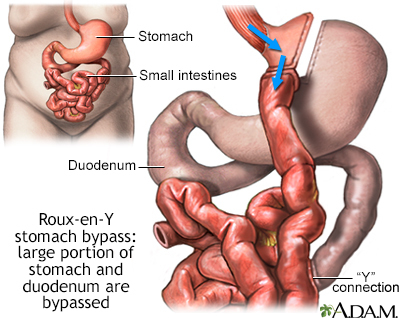
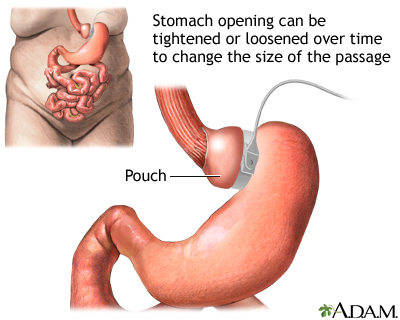
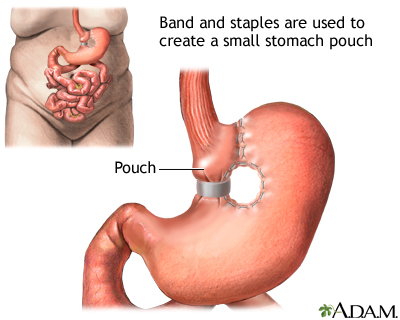
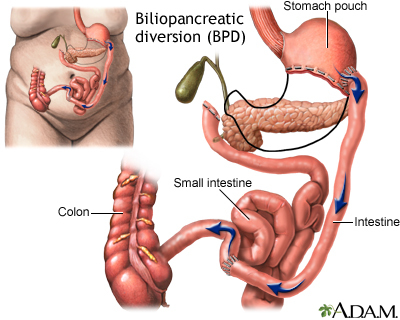

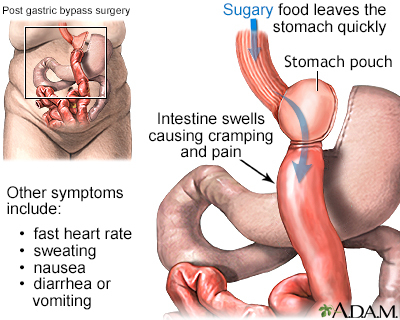
Eisenberg D, Shikora SA, Aarts E, et al. 2022 American Society for Metabolic and Bariatric Surgery (ASMBS) and International Federation for the Surgery of Obesity and Metabolic Disorders (IFSO): Indications for Metabolic and Bariatric Surgery. Surg Obes Relat Dis. 2022;18(12):1345-1356. PMID: 36280539 pubmed.ncbi.nlm.nih.gov/36280539/.
Richards WO, Khaitan L, Torquati A. Morbid obesity. In: Townsend CM Jr, Beauchamp RD, Evers BM, Mattox KL, eds. Sabiston Textbook of Surgery. 21st ed. St Louis, MO: Elsevier; 2022:chap 48.
Schirmer B. Operations for morbid obesity. In: Yeo CJ, ed. Shackelford's Surgery of the Alimentary Tract. 8th ed. Philadelphia, PA: Elsevier; 2019:chap 63.
Sullivan S, Edmundowicz SA, Morton JM. Surgical and endoscopic treatment of obesity. In: Feldman M, Friedman LS, Brandt LJ, eds. Sleisenger and Fordtran's Gastrointestinal and Liver Disease. 11th ed. Philadelphia, PA: Elsevier; 2021:chap 8.
At her biggest, Christina Mandeville — a mother of three — was 350 pounds and suffering from multiple ailments. UF Health dramatically turned her life around,…

Kimberly Willoughby never felt good enough. Too short. Too overweight. She believed that everyone else deserved a good life, but not her. It’s taken her many…

Gastric bypass surgery has given new lives to people who are severely obese. The procedure allows food to be rerouted past most of the stomach so less is digested, and some patients have...
Gastric bypass isn’t a highway, but for some obese patients it’s the most effective route to losing weight. This surgical procedure...